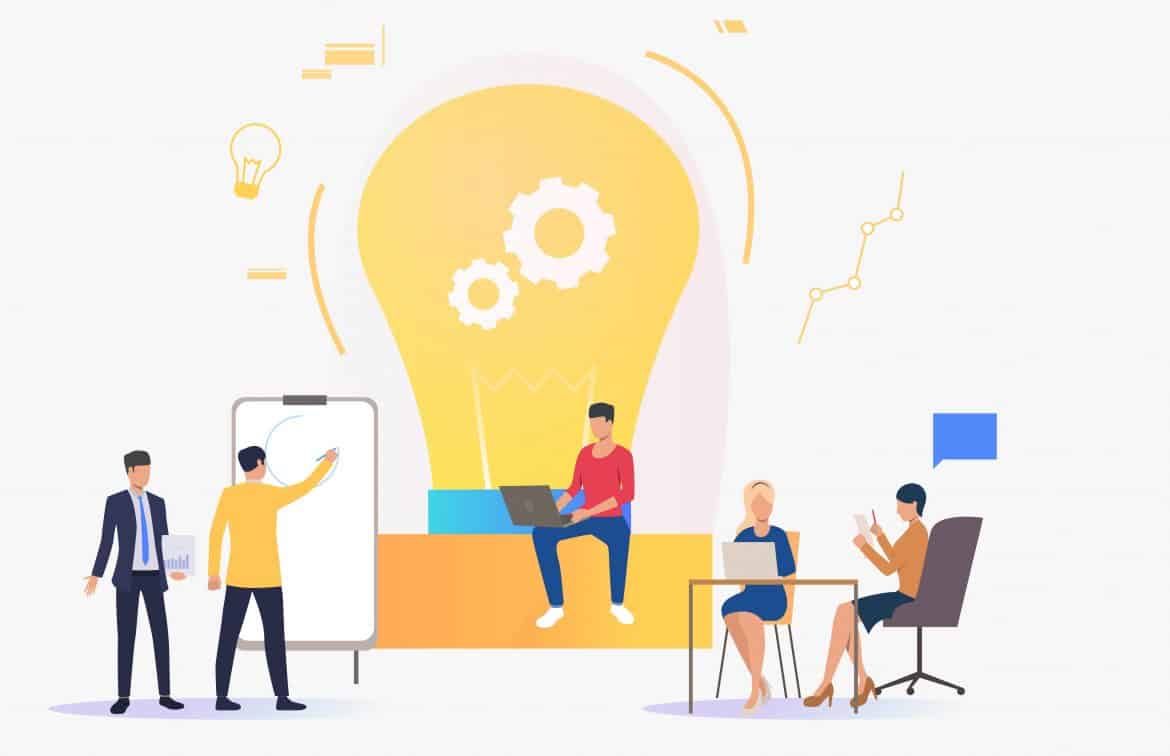A Guide for HR, L&D and Data Leaders looking to Create a Data Literacy Program
Source: katemangostar
Introduction
Over the past several years, we’ve seen companies scrambling to hire teams of data scientists, data engineers, and data analysts in the race to become “data-driven”. Studies show that the return on these expensive hiring efforts has been lacking.
For example, according to a New Vantage Partners survey, in 2017, 37% of firms said that they were “data-driven”. Despite record hiring of data science talent and ever-rising salaries in the interim years, by 2019 the percent of firms calling themselves data-driven fell to 31%[1].
Why are companies struggling to become data-driven?
In its 2020 survey, New Vantage Partners observed that:
Companies continue to focus on the supply side for data and technology, instead of increasing demand for them by business executives and employees. It’s a technology push rather than a pull from humans who want to make more data-based decisions, develop more intelligent business processes, or embed data and analytics into more products and services.
Furthermore, the survey found that:
Over 90% (of respondents) report that the challenges to becoming data-driven are in people, processes, and culture—not technology. Perhaps not surprisingly, only 15% have deployed AI broadly into production—because that is where people and process issues come into play.
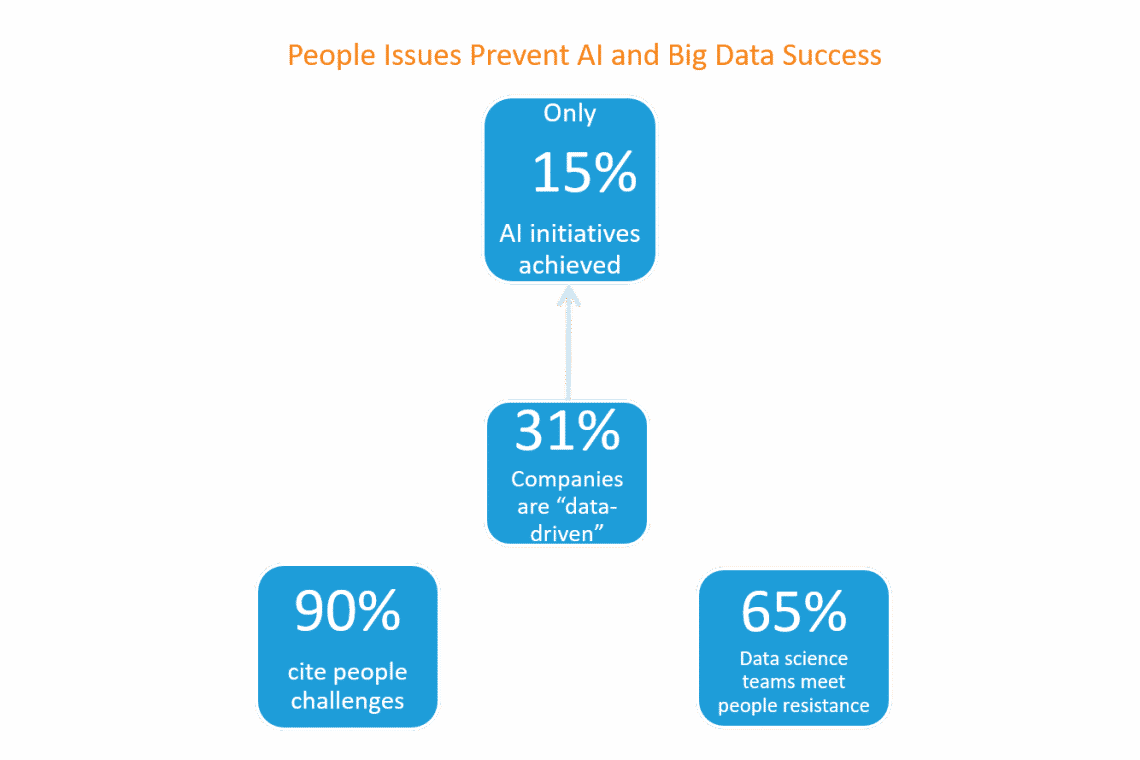 When it comes to the “people, process, and culture” aspects of achieving AI and big data goals, a critical factor for the success of enterprise-wide big data initiatives has largely been missing – organizational data literacy.
When it comes to the “people, process, and culture” aspects of achieving AI and big data goals, a critical factor for the success of enterprise-wide big data initiatives has largely been missing – organizational data literacy.
65% of data science initiatives are met with employee resistance. Without data literacy capabilities, non-technical employees neither have the ability nor the willingness to embrace and collaborate on insights that the data science team brings to light.
The result is a series of failed data science initiatives, a lack of data-driven culture, and an organizational resistance to the adoption of data-driven strategies.
As with most big organizational achievements – data science is no exception – success comes down to people.
“People” is the realm of Human Resources. Historically, HR has not been tasked with educating and motivating employees across the organization about technical issues such as data analytics and statistics. This has typically been the realm of siloed business units and technical team leaders.
However, to truly capitalize on data projects and achieve a large-scale return on investment in their data science teams, organizations need to create a human resources “bridge” that allows the data science team’s capabilities to cross over into the business functions and the people that manage them.
How can they build this bridge? Through data literacy learning and development programs.
What is Data Literacy?
Data literacy is the ability to collect, manage, evaluate, and apply data in a purposeful manner within a given job role. A data literate organization is one in which business people and functional employees can embrace and use data in all that they do.
Employees who are data literate can:
- do their own critical thinking and analyses using data;
- make data-based decisions rather than experience or intuition-based ones;
- use data to communicate ideas and to help create new products, business models, workflows and strategies;
- understand data visualizations
An employee’s ability to effectively use data relies on them possessing a set of skills (outlined later in this guide) that allows them to use data individually and collaboratively to inform their roles and responsibilities in the organization.
As with any type of “literacy”, the degree to which employees are “literate” or “fluent” in data can and should vary according to their roles and responsibilities and the degree to which they will need to use the language of data to communicate.
Check out our infographic on Upskilling for Data Literacy for more stats!
Why Establish a “Data Literacy Learning Program”?
Today’s economy is data-based economy, fueled by the “oil” that is big data. The multitude and variety of data that businesses and their employees are flooded with on a daily basis require employees to employ higher order skills such as critical thinking, problem-solving, computational, and analytical thinking using data.
These skills are not easily taught or acquired on an ad hoc basis. If employees and managers are left to acquire data-related technical and analytical skills on their own the results and the impact will be inconsistent and ineffective.
In fact, an Accenture study[2] found that:
- 75% of employees are uncomfortable when working with data.
- 1/3 of employees have taken a sick day from work due to headaches working with data.
- A lack of data literacy costs employers 5 days of productivity translating to billions of dollars in lost productivity per employee each year.
Moreover, a 2019 Deloitte survey of executives at large companies found that 67% of executives are not comfortable accessing or using data resources.
The issue is that current on-the-job training that focuses primarily on enhancing business domain knowledge and skills sends the message that mastering data skills is not important and does not support managers in feeling comfortable adopting data-driven approaches.
Yet data skills are required for both companies and individual employees to succeed going forward. Therefore a focused effort to upskill employees with data-related skills is needed.
What Data Literacy Skills Should Employees Develop?
Data science and analytics is a wide and diverse field that incorporates computer science, programming, statistics, math, algorithms, machine learning, and more. A data literate employee does not have to possess these skillsets by any means. If they did, they would be data scientists!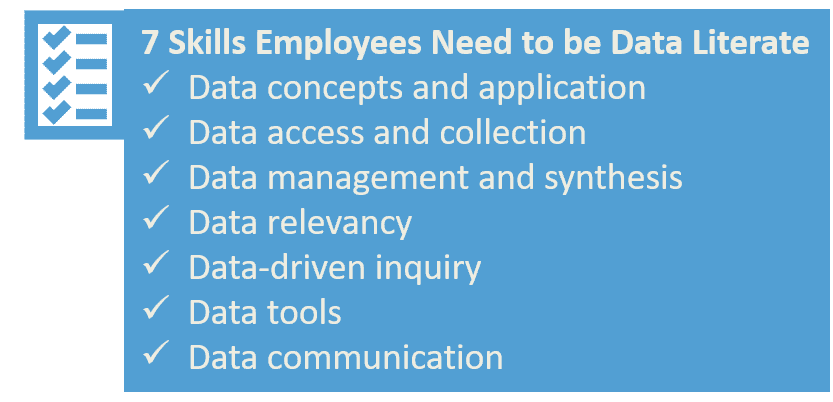
It’s important that learning and development program designers understand that data literacy transcends any single business discipline and is still an emerging concept. As such, data literacy touches on a potentially broad scope of skills that entail varying levels of technical and analytical expertise.
Generally, employees should strive to acquire some or all of the 7 skills that we outline below to be able to create value out of data and understand data science and analytics outputs.
1. Data concepts and application
Employees need a foundational understanding of the uses and applications of data. They should understand the high-level issues and challenges associated with data. They should also understand the importance of data and be familiar with concepts such as data ethics and data security.
2. Data access and collection
After building a foundational understanding, the next building block for using data to ask questions and inform decisions is employees’ ability to access and find information in multiple data sources. Employees should be knowledgeable about which sources exist and what information is contained therein.
They should be able to assess the trustworthiness and usefulness of data sources, too. Therefore, it is important in the planning stages of your data literacy program to carefully map out and address issues of data access and automation (more on this later).
3. Data management and synthesis
Another key building block is the ability to organize, explore and make sense of multiple types of data given the context of the employee’s role/business. Employees should become familiar with concepts and techniques for pooling different data and results and determining their impact.
4. Data relevancy
A misunderstanding of which data to use in their daily job is a key barrier to employee data literacy because the employee who misunderstands data feels overwhelmed when the results of their efforts are not meaningful. Employees should, therefore, understand how different types of data are relevant to different problems and questions and be able to prioritize data for use. They should understand the relationships among data from multiple sources.
5. Data-driven inquiry
Employees should eventually be able to engage in an ongoing process of identifying business problems and forming questions or hypotheses about these. This is essentially basic data analysis. They should have a sense of how to collect and analyze information and data or be able to seek out someone who can help them do this.
This is where the bridge to the data science team can be formed internally. Data scientists can help a data-savvy employee translate their information inquiry into an action plan.
6. Data tools
Data exploration and analytical tools and platforms are continuously evolving. Employees should have knowledge of common data analysis tools and techniques and should be able to select and apply the appropriate ones.
7. Data communication
Employees should feel comfortable both receiving and making communications about data from and to a variety of stakeholders. They should be able to frame why data is useful and to whom in ways others can understand. They should be schooled in data visualization techniques and options and be able to critically assess graphical representations of data for relevance and errors.
A Roadmap for Establishing Data Literacy
by the end of 2020, 80% of organizations will have started to roll out internal data literacy initiatives to upskill their workforce.
Human Resources has been hard at work sourcing, recruiting, and hiring expensive, hard-to-retain data scientists over the last few years. Now it also falls to HR to create a foundation for developing organization-wide data literacy to ensure the success of those data science resources. This is no easy task.
Along with data leaders, HR learning and development managers must find a way to effectively educate the rest of the organization so that data science can truly make a strategic impact.
To this end, we’ve put together a high-level roadmap for rolling out an enterprise-wide data literacy program.
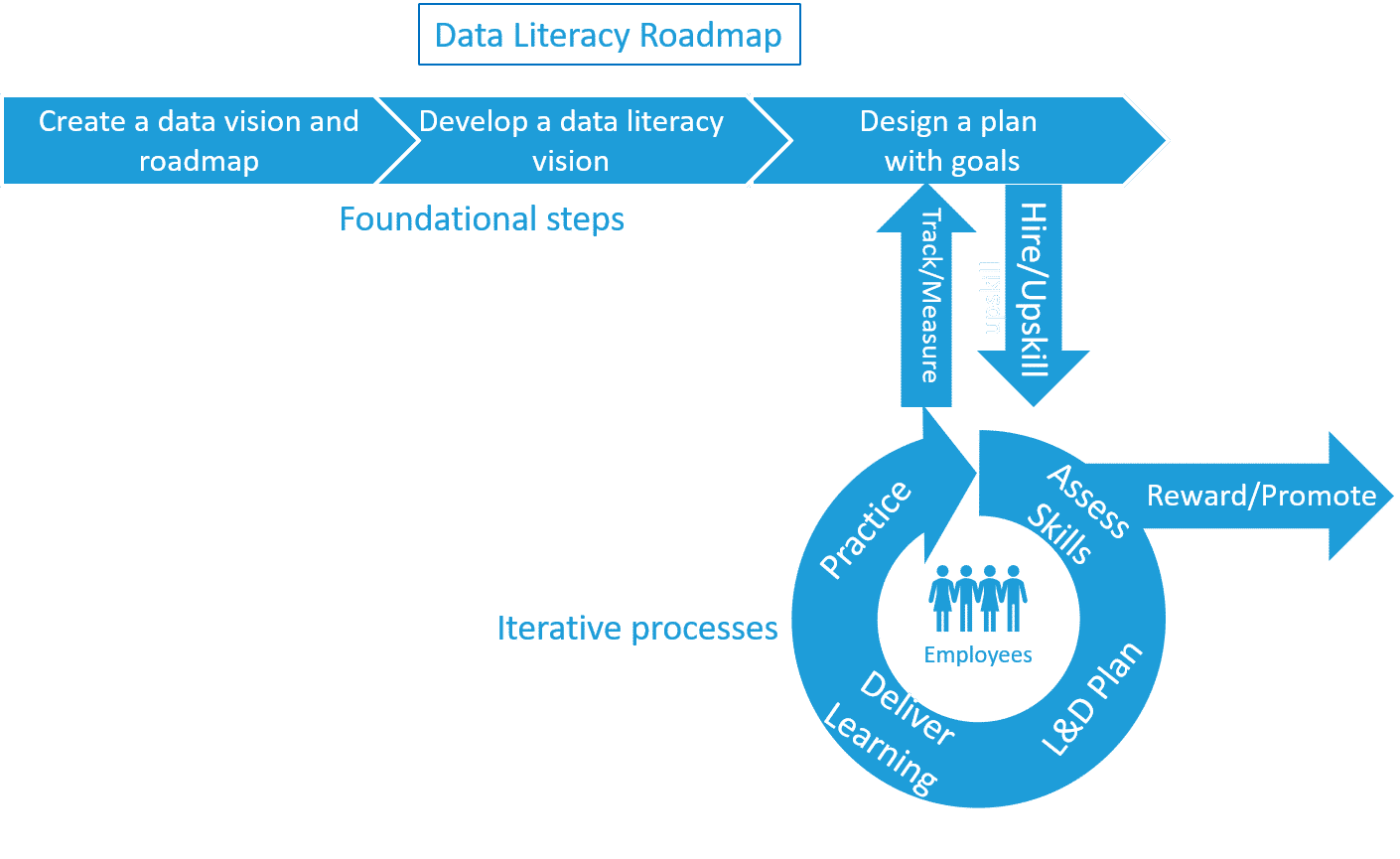
Data literacy requires a clear data vision, planning and iterative learning and development processes
1. Create a data vision and roadmap
Any organization that has been investing in data science and AI capabilities should have already undertaken the creation of a data vision and strategic data roadmap. (For more information on how to do this, see our Guide to Building an Advanced Analytics Team). In the process of doing so, data and IT leaders will have put in place trusted data sources, data governance, and installed a data leader at the C-suite level.
They will have identified and prioritized areas of the business where data can drive value.
These steps are a critical pre-requisite to creating a data-literate organization and reducing the friction around understanding and using data.
As a final critical step in this phase, management and HR need to communicate across the enterprise that data is a strategic business tool that creates value. Using the data vision and roadmap as context, they should be able to explain to management and employees why data matters, how it creates value, and how it impacts the business, in order to provide employees with some context of data use in their daily roles.
In the absence of a clear vision for data and a plan to create value out of it, employees will lack understanding of why they are being asked to upskill themselves in the realm of data, and, as a consequence will lack the motivation to do so.
2. Develop a data literacy vision
Upper management support and vision for creating data literacy is the key to creating a data-driven culture. The C-suite must collaborate with Human Resources on its vision for data literacy and define it clearly as it applies to talent management.
A data literacy vision should detail desirable skills, abilities, and the level of literacy required for different business units and roles.
Questions to address include:
- Does management envision a beginner’s level of data language understanding for everyone?
- Do certain roles in operations or strategic planning require a comparative analysis level of understanding?
- Which roles should we prioritize for data literacy upskilling?
- How data-driven does senior management want the organization to be across various levels?
Business, data, and HR leaders then need to create a framework to achieve literacy goals, measure progress, and maintain data literacy. This includes deciding what skills are required of whom, how to measure and track skills development, to what degree decisions should be data-driven, and to what degree different parts of the organization should use data in achieving their strategic goals.
3: Design a plan to achieve data literacy goals
When embarking on a data literacy program, HR must decide if it will roll out a data education program to the entire organization or start with a small pilot group of employees. The decision will depend on factors such as organization size, industry focus, budget, resources, culture, competitive position, and other factors.
In general, you will want to identify and develop data literacy “evangelists” for the most important areas of the business first. You’ll want to plan how to upskill these data evangelicals quickly and share results, successes, and failures with team members. Data evangelists can also inform HR of any challenges or issues that arise on the path to educating team members.
HR should also begin researching, deciding, and planning for what types of educational formats are best and what budgets and resources are needed. It’s important also to consider the appropriate timing for different data literacy educational needs in light of the previously developed framework. HR may have to develop a prioritized list of employees and departments.
In addition to the rollout plan, data, IT, and technical leaders must think through issues surrounding access to data, compliance, privacy, and security across the organization. They should ensure that as employees across the organization start to use new data in new ways that the data does not become corrupt and is not used in unethical or useless ways.
A key decision at this point is to decide what kind of automation tools should be adopted to allow employees to access data and conduct self-service data science and what degree of data literacy should be achieved before embarking on their use.
HR, business managers, and technical leaders should try to make these decisions together, for example through the establishment of a data literacy taskforce.
4. Assess workforce data skills
Workforces are highly diverse. At the same time, modern employees expect personalization of career and skills development programs. Therefore, when it comes to creating a data literacy program, it is important not to treat everyone the same.
Human Resources will need a way to assess team members from different functions and business units for baseline data skills. Although a basic foundation is needed for most employees, the data skills needed might vary by role. HR should thus work with business leaders to determine how to assess baseline data skills for each employee.
Assessments should ideally be administered at the start of employment or during the recruitment process for new hires. That way, when a candidate is hired, HR will already know what kind of data literacy learning and development opportunities should be offered to the new hire over time.
Employees who have not yet been assessed for data skills should be tested first before embarking on any learning and development. The value of initial assessment results for existing employees is that they allow HR and business leaders to engage in an initial “skill mapping” exercise.
If the data literacy team has executed Steps 1 and 2 effectively, it should have an idea of the data skills needed to perform in various roles. HR can then map current employee data skills to these roles and determine where there are gaps and of what nature. They can then come up with a learning and development plan to remedy these gaps (see step 4).
Skill mapping for data literacy should also assess the employee level of interest in learning data skills. For example, suppose one sales employee has knowledge of business intelligence tools, however, this person prefers to be outselling and engaging with clients. Another sales employee, however, may lack knowledge of business intelligence concepts but be very interested in learning and working with data.
Skill mapping should identify this type of situation to help HR and team leaders make future decisions about hiring and career development.
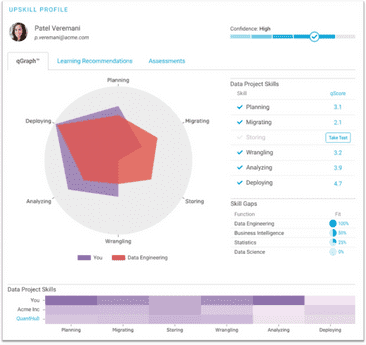
Conducting an assessment for each employee to determine baseline data skills allows HR to deveop individualized L&D programs for understanding data.
It’s worth noting that this is a phase on the road to data literacy where QuantHub assessments can help. It can be overwhelming for a large organization to consider assessing all its employees for data skills, even if this effort is spread out over time.
It’s important to find an efficient and consistent solution to assessment and to be able to adapt it to the organization’s need, or this critical step risks being overlooked.
5: Create individual and team data literacy learning and development plans
According to Qlik,
Only 24% of business decision-makers from junior level managers up to the C-suite feel confident
in their ability to understand, work with, and communicate using data.
It also found that just 34% of firms provide data literacy training.
HR is typically responsible for helping business managers identify and track areas of improvement and development opportunities for employees. It also organizes the timing and mechanisms for learning and development through which the requisite content is delivered.
It’s no different when it comes to data literacy education.
Once HR and managers have a picture of an employee’s or a business unit’s strengths, weaknesses and gaps in data skills, HR can begin to construct personalized and efficient learning programs that allow employees to upskill in data use and analytics.
In addition, HR should create a program to develop baseline data literacy skills into the organization’s new hire onboarding training. For example, onboarding could include teaching new employees about where to find data related to their role within the organization, how to access it, governance rules, data ethics policies, basic analytical tools used and so forth.
6: Create data literacy delivery modules
Delivery of data literacy skills most likely will need to be executed at different “grades” or levels over time from beginner/introductory all the way to self-service data science and analysis. Introductory or standardized courses might be needed to make sure everyone is on the same page in terms of basic data concepts and jargon, data access, data ethics, and awareness of potential uses.
From there, the focus of data literacy education might be on providing the skills and tools to deal with big data on the job and educating employees on how these skills are transferable in their day to day roles. Additional learning modules might be very specific in terms of data science usage in a discipline such as Human Resources or Product development.
Delivery methods might consist of anything from online courses to workshops and might include webinars, quarterly meet ups, in-services with the data science teams, mentoring, and project-based learning on the job.
Whatever methods of education are put in place, they must ensure consistency of skill development, measure progress and identify data skills gaps.
7: Provide opportunities to practice and reward data literacy skills
As mentioned previously, employees need appropriate access to data systems and tools to embrace and develop their data literacy. Management should provide opportunities for employees to use and experiment with data. It should seek to motivate and reward employees who do so and who bring data-based insights to light.
Opportunities might include the use of data visualizations in everyday work and the facilitation of team discussions using numbers, charts and graphs. These opportunities can be built into job descriptions. Business and functional team members should have the data science team on autodial and feel comfortable reaching out for support and having conversations about data and business problems.
Organizations also need to put in place strong support for the use of facts in decision making and promote a culture that celebrates curiosity and critical thinking in order to scale and maintain data literacy.
8: Track, measure, rinse and repeat
As mentioned before employee data literacy levels at the initial assessment will be varied and inconsistent. It’s not enough to assess data literacy skills, put tools in front of employees and cross your fingers that they will become data-driven in their actions.
HR should reassess employees periodically to determine individual areas of development and need and to provide a feedback mechanism for the data literacy program.
This all takes time. So, business leaders must allow their employees to invest the time required to become data literate and improve skills. Over time, as new hires are put on a personal path to data literacy and as employees become more comfortable using and thinking about data in their day to day roles, data thinking will become part of the corporate culture.
Employees across the organization will be better able to use data in a multitude of ways to develop a competitive edge.
Finally, it’s important to communicate data literacy progress across the enterprise and on an individual basis. Tracking and communication of progress are also key to continue evaluating your data roadmap, vision for organizational data use and literacy and re-aligning of assessments and learning and development programs accordingly.
What does all of this mean for hiring, onboarding, and learning and development?
If no one outside the data science and analytics team understands what is being said and why it won’t matter if data and analytics offer immense business value. Extracting insights and value from data to solve business problems and identify opportunities can no longer be the sole realm of the data science and analytics team.
Data science is as much a people issue as a technical one.
Understanding data and what it can offer now is an essential skill that all current and future employees need to operate productively in the new data economy.
Recruitment and hiring should, therefore, be the first step to start creating the organizational shift towards data literacy. In the hiring process, HR and hiring managers should set expectations with candidates that they should be using data in their roles and while interacting throughout the organization. New hire onboarding should thus incorporate some basic data-related training according to departmental needs and showcase future learning opportunities.
After testing both new candidates and current employees to baseline data literacy and engaging in personalized skills mapping, HR should assign employees to learning programs that address areas of personal strengths and weakness and put each employee on a path to understanding data in their role. Learning and development should track, measure, communicate, and reward progress on these data literacy strengths and weaknesses over time.
This type of long-term planning and investment in educating the entire organization about how to access, understand and analyze data on the job will greatly accelerate any efforts and investment that data science, machine learning and AI teams are making.
The result will be a “bridge” of skilled users that can embrace and leverage data across the organization for the benefit of all and for maximum value.
Interested in learning more about how you can develop a data-driven culture through upskilling your employees for data literacy? Contact sales@quanthub.com or check us out here.
[1] https://hbr.org/2020/03/how-ceos-can-lead-a-data-driven-culture
[2] “The Human Impact of Data Literacy”
